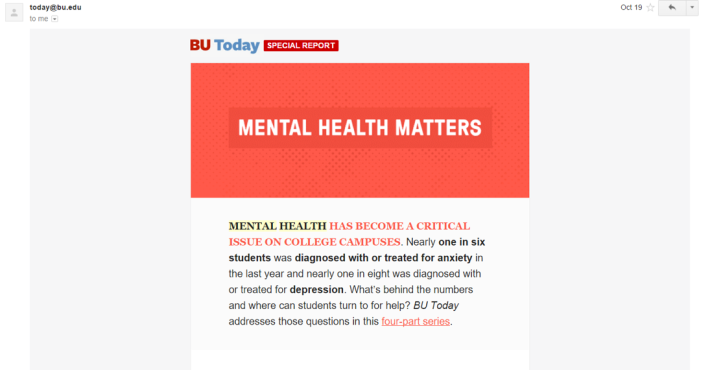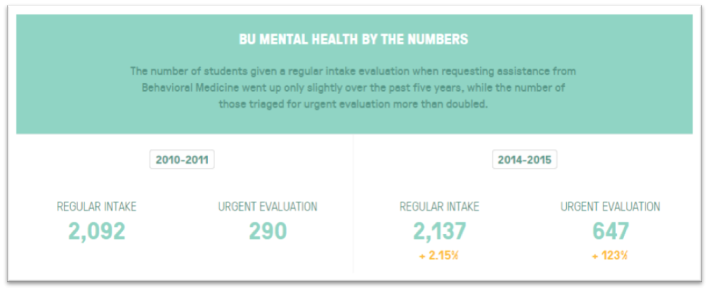One way that colleges are influencing student mental health
BY NICK STAPLER

CBS / Via gifbay.com
In a Buzzfeed article about college mental health, “how to find the campus counseling center” is written in bold lettering, stating one of the many things people wish they knew in college. “Knowing a safe place to get away” can also be found along these health tips, along with other student-centered tips. All of the tips in the article and throughout the comment section point to things students should fix themselves. College students will likely already have enough responsibilities to deal with, without adding this article to the list. Should students alone have to prepare themselves for the academic and mental transition to college stress? Instead, I think that colleges should be partly responsible for some of the effects of college stressors.
For many, college can be late night study sessions, multiple exams on the same day, or the pressure to make new friends. College life is full of possible mental health agitators such as these. Stress can build up from day-to-day activities and can take a mental toll on college students. For me, the transition to college signified new-found independence but also my worries about my capability to manage that independence on my own. College students shouldn’t have to deal with mental health problems on top of their other obligations. That is why it is important to ask, what are colleges doing to address mental illness on campuses?
Before attending Boston University, I was just another pre-college kid. Compared to high school, College seemed to be in a different universe, full of new places, people and activities. My only true exposure to college life was through my older brother whose main response was “Yeah, it’s pretty cool.” I knew my older brother had struggled academically through college, but I didn’t know much else about his college experience. Since the majority of colleges that I applied to were out-of-state, it was difficult to find a cheap and simple way to experience college life. Fulfilling those qualifications, college newspapers became my prime form of information. These online and printed newspapers have been an invaluable insight into the college life had imagined. That is why I will view two different newspapers as mediums used by neighboring colleges, BU and MIT, to see what colleges are saying about student mental health.

Many BU Today articles are written by graduate students and other professional writers from the office of Marketing and Communications on campus. Over the year and a half that I have attended BU, I haven’t heard much discussion on campus about mental illnesses. The fact that there had been minimal publicity for the mental health topic, was concerning. The majority of articles displayed the experiences of the happy, succeeding students. It is hard to see anything beside the exciting, fun, and happy norm of college life, shown in each article thumbnail picture. On October 19th of 2015, BU Today posted a four-part series on mental health in response a sudden rise in mental illnesses on campus.

The Mental Health Matters series addresses many of the mental health concerns that have always been linked to college life but had not been given a recent public presence. The mental health series first answers why mental health is a concern on campus then distinguishes what mental illnesses are and who might have them. Within its first bolded paragraph, part one of the series attributes its motivation for publication to a rise in the number of students seeking campus mental health services, apparently seeing the rise as a cause for concern. One might think that colleges would find a rise in the usage of mental health services to be positive since it is associated with students receiving the treatment they need.

One commenter writes, “The first part of this article makes it seem like my generation Just Can’t Cope, as if we did this to ourselves. That’s pretty messed up to insinuate.” The comment was written in response to A Growing Challenge which attempts to explain the rise in need for campus health services but instead writes about how the actions of this generation’s students may be to blame for their mental illnesses. Another of the students, username “frustrated” commented, “this kind of rubbed me the wrong way. It portrayed mental illness as something you decide to have. There is a difference between stress caused by laziness and a mental illness.” “Frustrated” is right! There is a difference between mental illness and regular stress. One is obviously normal and, while unpleasant, is still manageable. While the disorder or illness, can be debilitating and can require professional attention. While BU’s accusations may contain some truth, the students are not the only cause of the supposed help-seeking crisis.
Deep within BU Today’s archives lies a 2011 mental health series titled Students in Crisis. It covers almost the same topics as the Mental Health Matters series in a similar manner. Both series emphasize a use of student stories to make mental illness more relatable to the stereotypical college students, such as the athletes, previous high school high-achievers, and etc. Part 2 of Mental Health Matters, for example, included the experience of a girl, Victoria Pae, who was “feeling overwhelmed with stress and anxiety” while double majoring at the time. She said that these feeling probably originated from the fact that that she wasn’t doing as well as she did in high school. While this student story emphasizes the relevance of mental illness as an issue on campus, it also focuses on the college caused ailments: stress, fatigue, worry, feelings of inadequacy, and etc.
By incorporating student stories, BU Today makes mental illness a flexible puzzle piece that students can fit into their lives. These stories can be beneficial to creating a sense of empathy among students for those with mental disorders. However, they can also cause individuals to associate their symptoms of “healthy stress”, from school for example, with the medically-defined mental illness. When students self-diagnose in this way, they may seek unnecessary treatment which may contribute to the help-seeking crisis. Mass self-diagnosis of students can also lead to the normalization of the label of “having mental illness.” This can cause students to believe that their legitimate illness is something they should endure without proper treatment since it is “normal.”
As opposed to its scarlet and white colored neighbor, MIT portrays what most would think a private university’s outlook on mental illness would be. Appealing to its, no doubt, intelligent and logical students, the Massachusetts Institute of Technology’s news medium, MIT News, provides a research based, indirect look at mental illnesses. After scavenging through MIT’s archives, I could only found the two articles which had direct references to mental illnesses. Both articles were written by the same science writer, Anne Trafton, and focused on biological brain activity. One of the articles focused on the possibility of modifying memory-holding cells to develop new treatments for certain mental illnesses. This article and the second, which focused on the striatum, a frontal part of the brain, with connections to emotional decisions, only seemed to be recaps of the latest developments of ongoing studies. Neither article mentioned the significance of mental illness on campus. With this science/medical based approach to speaking about mental illness indirectly, MIT doesn’t make the general student population aware of mental illness being present on campus or educate students about steps to receive proper treatment. In a blog dedicated to telling students stories to incoming students, Rachel Davis wrote “I lost hope. I started to see no reason to live. I stopped seeing the point of going to college and suffering through all the pset deadlines, exams, and countless all-nighters.” She may have just been experiencing the expected stresses of college life, but knowing where to find help would be then having no hope at all.
Each of these prestigious university’s newspapers demonstrated a differing view of mental illness. Each succeeded in drawing attention from the general population or the population experiencing mental illnesses, but not both. These results are due to the newspaper’s failure to provide the entire “story” of mental illness to readers. This story is a blend of the two types of outlooks on mental illness that the newspapers feed to the students. MIT News had a medical or scientific focus on mental illness while the BU Today attempted to relate to all students through other student experiences, most being experiences with mental wellness instead of illness. Jack Coulehan explained this blend with his idea of a cultural hermeneutic model. Coulehan described the treatment of mental illness by first interpreting the person’s culture and then blending scientific and medical treatment in with that culture to create a sort of bio-cultural narrative. This narrative allows the person to “accept” medical treatment because it relates to them personally and provides a sufficient, scientific “why”. Most colleges are obviously making an effort to deal with mental illness. College newspaperss represent quick and modern mediums through which to convey information. They accomplish what they were essentially meant to do, drawing the attention of the maximum audience. It is questionable whether reaching the college masses is doing enough on a college’s end when concerning a controversial topic like mental illness.
I want to start with stating that your line about the flexible puzzle piece is outstanding. I agree with you that the way mental illness is discussed on college campuses is far too broad and conflates normal mental stress and true mental illness. As you are aware, based on the DSM 5 and DSM IV, for something to be considered a true mental illness, the behaviors must be disruptive and deviate from a norm. Stress is normal in college, and just because you feel stress during crunch time does not indicate that you are mentally ill. The one question I have is that you are insinuating that the way we discuss mental illness on campus is a means to an end. What is the end? What benefit is there in producing a populous that is so hyper aware of mental illness that they diagnose themselves and seek medications that for the vast majority will succeed in only dulling their emotions instead of “fixing” anything?
LikeLike
I want to start with the fact that I’m really glad you used this title instead of the other one you were thinking about… it fits so much better, Nick. But, I also didn’t realize how parallel our arguments are. You say that because of how BU is discussing mental health, students are seeking help when they don’t need it. That’s basically the gist of part of my article that I wrote, you should check it out. I think that this is a great new look at the way mental illness is discussed. Do you have comments from the article that MIT put out, like the ones you pulled from BU Today?
LikeLike
This a huge topic of discussion, and I think you did a great job of highlighting the weaknesses of a university’s role in mental health. I think BU would benefit from reading your essay.
LikeLike